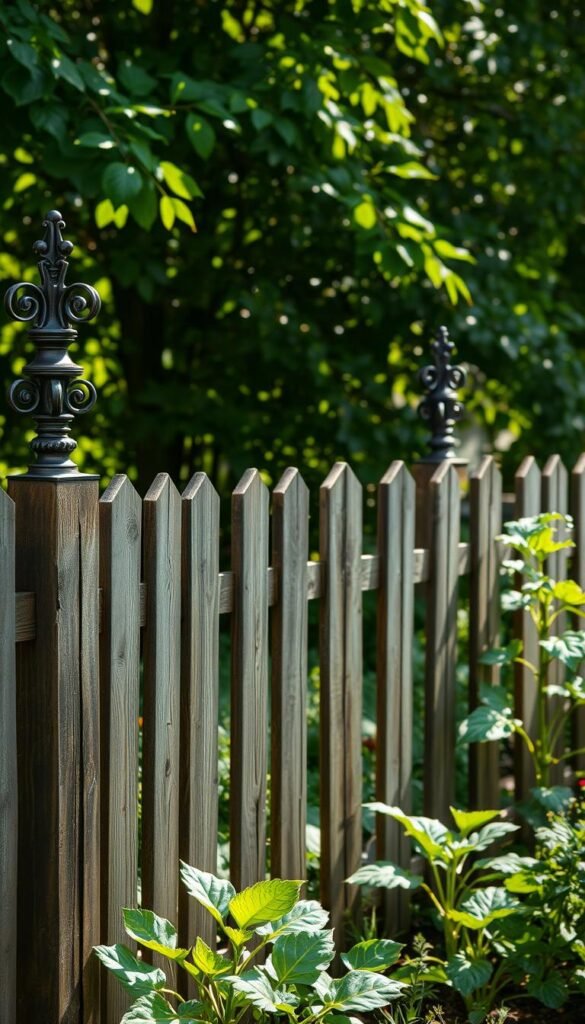Want to keep your plants safe while making your outdoor space look great? The right barrier does more than mark property lines—it becomes a guardian for your crops and a stylish addition to your landscape. Whether you’re dealing with hungry deer or curious neighbors, a well-designed solution keeps unwanted visitors out without sacrificing charm.
Choosing materials that blend durability with visual appeal ensures your growing area stays secure year-round. Taller options deter jumping animals, while tighter gaps prevent smaller critters from sneaking in. At the same time, textures like wood or metal can complement your existing decor, turning a practical necessity into a design feature.
Beyond protection, these structures help organize your planting zones and create a sense of privacy. They act as a clear boundary, reducing accidental trampling and keeping pets or kids from wandering into delicate beds. With smart planning, your enclosure becomes part of the overall aesthetic, supporting climbing plants or serving as a backdrop for flowers.
This guide walks through options that balance practicality with personality. You’ll find solutions for every budget and style, from simple wire setups to artistic trellis designs. Let’s explore how to build a defense system that works as hard as your green thumb does.
Clarifying Your Garden’s Fencing Needs
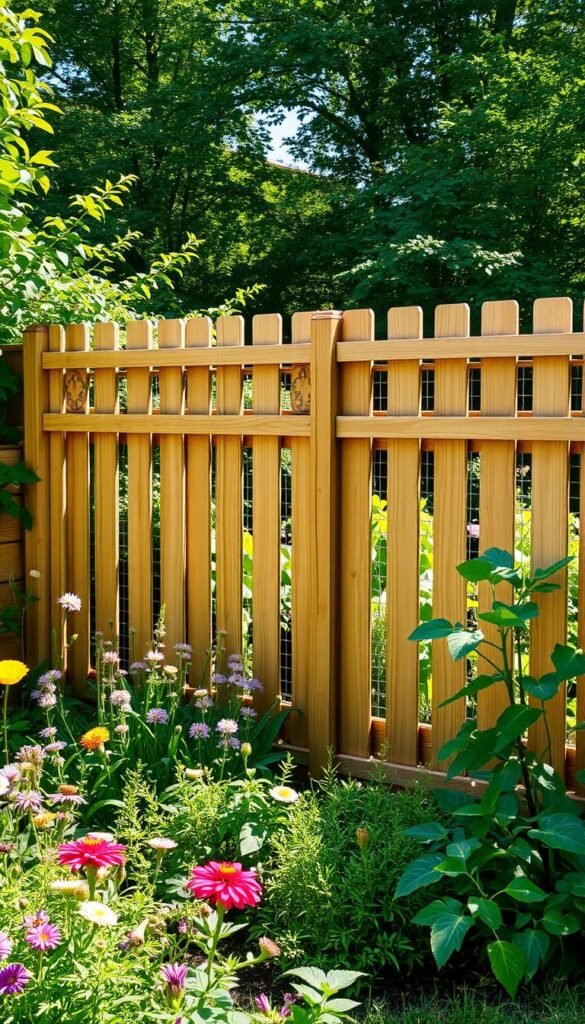
Effective enclosures begin with assessing your plot’s unique challenges. Local wildlife and neighborhood dynamics shape your barrier’s design, balancing protection with personal style.
Identifying Intruders and Wildlife Challenges
Deer clear 4-foot barriers easily but hesitate at 7-foot metal mesh walls. Smaller troublemakers like rabbits squeeze through gaps wider than 1 inch. Classic picket designs work for dogs but fail against determined diggers.
Consider these animal-specific solutions:
- Open spaces: 8-foot fencing deters deer
- Tight grids: ½-inch mesh blocks rodents
- Buried edges: 12-inch underground barriers stop burrowers
Setting Goals for Privacy and Aesthetics
Visibility from streets or nearby homes affects plant choices and relaxation. A lattice-top design offers seclusion while allowing sunlight through. Match materials to your house’s exterior – wrought iron enhances modern homes, while cedar blends with rustic settings.
Remember: Your barrier should disappear into the landscape when done right, becoming a quiet guardian rather than an eyesore.
Choosing the Right Fence Style for Your Vegetable Garden
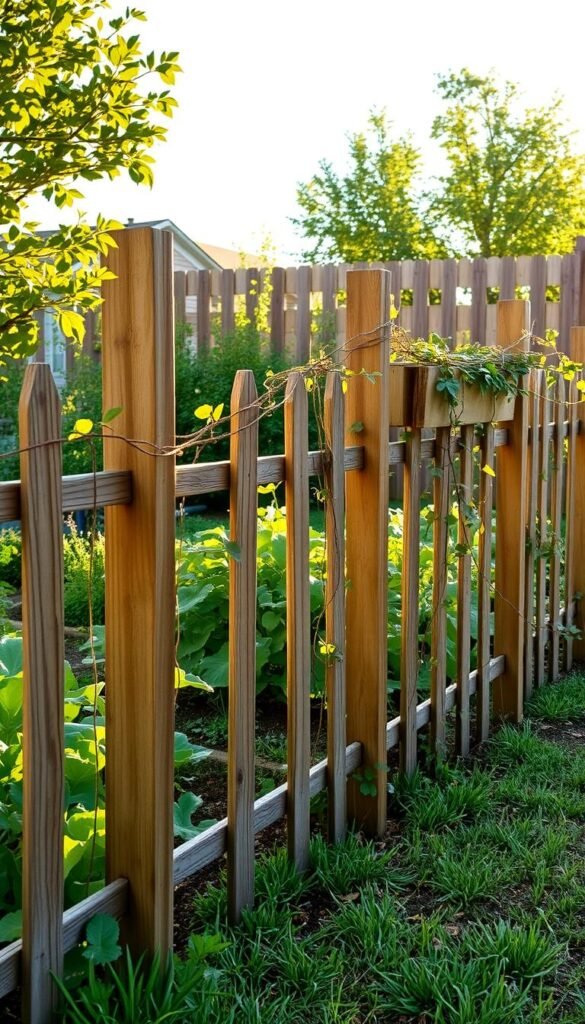
Your green haven deserves a guardian that works as hard as you do. The best solutions act like silent partners—keeping threats at bay while blending seamlessly into your growing space.
Practicality vs. Visual Appeal
Think of your barrier as a multitasker. Combining materials like cedar posts with galvanized wire mesh creates a fortress that looks like part of the scenery. One gardener put it perfectly: “My beans climb the decorative trellis while rabbits stare helplessly at the hidden hardware cloth beneath.”
Sunlight matters more than you might guess. Solid barriers might block wind, but they could also shade your tomatoes during peak growing hours. Semi-transparent options like split rail with wire allow light penetration while maintaining security.
Your enclosure should mirror your approach to cultivation. Neat, symmetrical patterns suit formal plots bursting with orderly rows. For a wilder, cottage-inspired space, try curved lines or mixed-material sections that feel organic.
Ask yourself: Is this a forever fixture or a flexible protector? Permanent stone bases with removable panels adapt as your crops rotate. Temporary bamboo screens offer quick coverage for seasonal beds without commitment.
Backyard Vegetable Garden Fence Ideas: Functional yet Attractive Enclosures
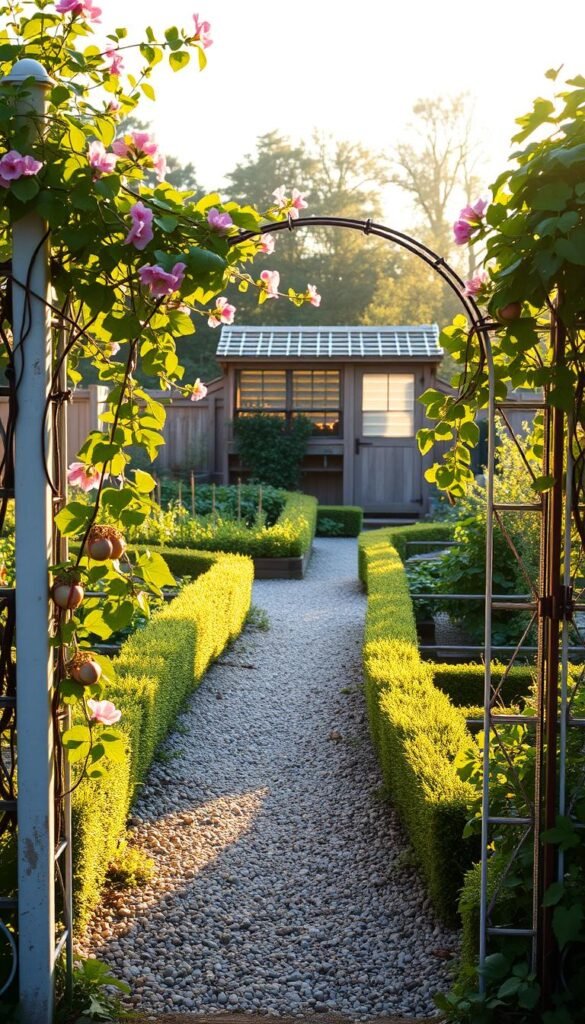
Your edible plot’s perimeter can be both a defender and a decorator. Professionals have installed over 25,000 enclosures in recent years, revealing smart patterns for merging security with style. Let’s explore how to create boundaries that delight the eye while standing guard.
Harmonizing Security With Visual Flair
Think of your barrier as a security system wearing couture. One gardener transformed wire mesh into art by weaving willow branches through the grid. “Rabbits can’t chew through metal, but the natural weave makes my plot feel welcoming,” they shared.
Try these dual-purpose upgrades:
- Decorative post toppers that deter birds from perching
- Lattice extensions supporting pea vines or morning glories
- Patterned metal cutouts that block groundhogs but cast artistic shadows
Mixing Time-Tested and Contemporary Materials
Pair aged barn wood with sleek aluminum rods for instant character. Modern composite panels resist rot better than traditional wood but mimic its grain texture. This blend creates depth while meeting practical needs.
| Style | Materials | Benefits | Best For |
|---|---|---|---|
| Rustic Modern | Reclaimed wood + steel cables | Weather resistance | Sloped terrain |
| Country Chic | White pickets + copper accents | Deters snails | Small plots |
| Urban Edge | Concrete base + laser-cut panels | Maximizes light | Raised beds |
Your barrier’s personality should mirror your growing philosophy. Whether you prefer crisp lines or whimsical curves, the right mix protects tender plants while making your space uniquely yours.
Exploring Classic Wooden Fencing Options
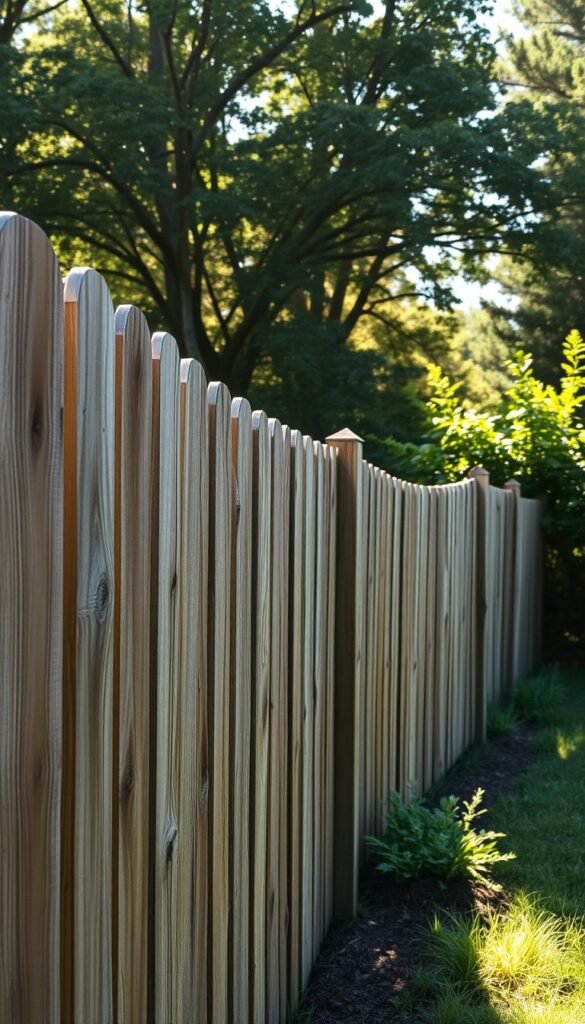
Natural materials create boundaries that age like fine wine, growing more characterful with each season. Wood remains a top choice for growers seeking warmth and versatility, offering solutions from polished picket designs to rugged recycled installations.
Rustic Charm of a DIY Wood Fence
Building your own barrier lets you balance cost efficiency with creative expression. One gardener shared: “My salvaged barn wood fence cost half the price of store-bought panels and tells its own story through weathered knots and cracks.”
Reclaimed timber develops a silver-gray patina that blends with natural surroundings. Unlike uniform new lumber, each piece has unique textures that add depth to your space. You control every detail—post spacing for visibility, heights for climbing plants, or decorative cutouts for personality.
| Type | Materials | Cost per Foot | Maintenance |
|---|---|---|---|
| Traditional Picket | Pressure-treated pine | $15-$25 | Repaint every 3 years |
| DIY Rustic | Reclaimed wood | $5-$15 | Annual sealing optional |
Stains or natural oils protect your wooden fence while showcasing grain patterns. For low-maintenance charm, let weather transform raw planks into silvery sentries. Pair with metal brackets or stone bases to boost durability without losing that handcrafted feel.
Remember: Your barrier should work with nature, not against it. A slightly uneven top rail or irregular slat spacing creates visual interest while keeping crops safe. It’s protection that feels alive rather than industrial.
Modern Materials: Metal, Mesh, and PVC Solutions
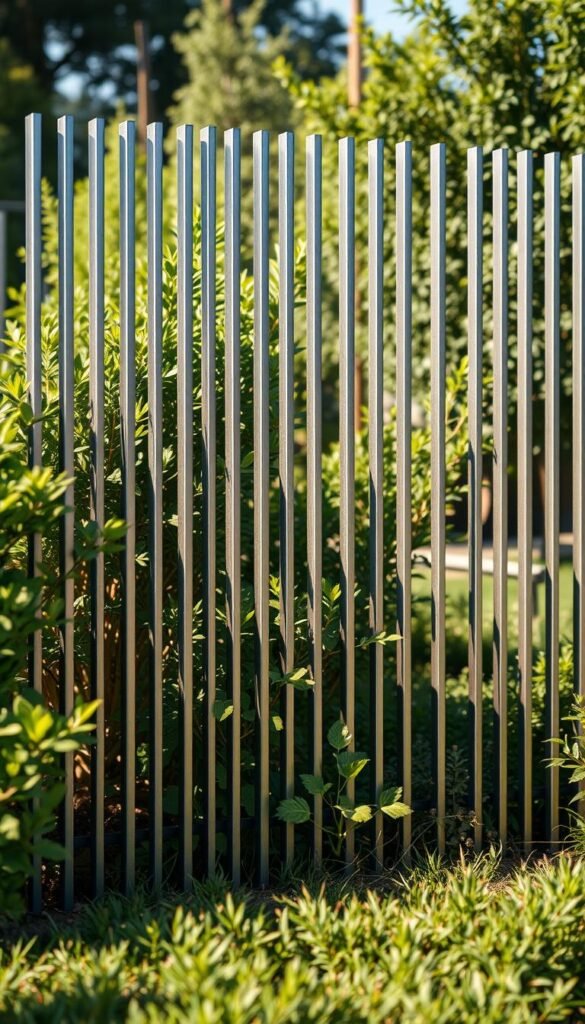
Today’s protective barriers combine industrial strength with sleek design. Unlike traditional options, these solutions weather storms and seasons while maintaining crisp lines and clean profiles.
Benefits of Metal and Wire Mesh Designs
Wire mesh acts like invisible armor for your plants. Its tight grid stops rabbits and chipmunks while letting sunlight flood your crops. One urban grower noted: “I watch my peppers ripen through the steel grid without worrying about midnight nibblers.”
Galvanized metal panels outlast wood by decades. They shrug off rain, snow, and UV rays without warping or rotting. Pair them with cedar posts for warmth, creating hybrid designs that blend ruggedness with natural charm.
| Type | Materials | Cost per Foot | Durability |
|---|---|---|---|
| Chain-Link | Galvanized steel | $10-$20 | 15+ years |
| Custom Welded | Powder-coated steel | $20-$50 | 25+ years |
These materials work smarter, not harder. Maintenance involves just an occasional hose-down, freeing your time for pruning and harvesting. Their industrial aesthetic complements raised beds and geometric layouts, especially in contemporary spaces.
For added versatility, attach wire grids to existing structures. They support climbing beans or flowering vines, turning functional barriers into vertical gardens. It’s protection that grows more beautiful each season.
Determining the Ideal Fence Height and Structure
The battle against garden invaders starts with strategic vertical planning. Taller barriers create physical obstacles, while smart designs add psychological deterrents. Let’s break down how to build upward defenses that match your landscape’s needs.
Optimal Heights for Deterring Deer and Rabbits
Deer leap like Olympic athletes in open spaces. A 7-foot height stops most adults, but add jagged tops or outward-angled mesh to discourage ambitious jumpers. One grower reported: “Our 6-foot barrier works because it’s wedged between two sheds—deer can’t get a running start.”
Rabbits play a different game. They’ll tunnel under low barriers instead of jumping over. Pair 3-foot-tall wire with 12-inch buried edges to block both approaches. This combo protects leafy greens and root vegetables equally well.
| Animal | Minimum Height | Key Structural Features | Post Depth |
|---|---|---|---|
| Deer (open areas) | 7-8 feet | Angled top, metal mesh | 24 inches |
| Deer (confined spaces) | 5-6 feet | Irregular top profile | 18 inches |
| Rabbits | 3 feet | Buried 12″ base | 12 inches |
Sturdy posts make tall barriers wind-resistant. Space wooden supports 6-8 feet apart, or 4-6 feet for metal frames. Deeper installations prevent leaning—dig 1/3 of the total height into the ground. For example, an 8-foot deer fence needs posts sunk nearly 3 feet deep.
Remember: Your vegetable garden’s layout affects these numbers. Sloped land might require tiered barriers, while flat plots need uniform heights. Measure twice, build once—your plants will thank you.
Innovative Designs for Functional Fencing Layouts
Transform your growing space into a multitasking masterpiece with smart layouts that protect crops while boosting productivity. Strategic designs turn ordinary barriers into growth accelerators and style statements.
When Structure Meets Growth Potential
Lattice panels aren’t just pretty patterns—they’re productivity powerhouses. One gardener raved: “My sugar snap peas climbed the diamond-shaped grid so fast, I barely needed twine!” These crisscross frameworks create natural ladders for climbing plants while filtering sunlight for shade-loving herbs below.
Consider these dual-purpose upgrades:
- Modular sections that adjust as your crops expand
- Angled supports directing vines away from walkways
- Removable panels for easy harvesting access
| Lattice Type | Material | Cost per Foot | Best For |
|---|---|---|---|
| Diamond Grid | Pressure-treated wood | $18 | Cucumbers, pole beans |
| Square Pattern | Vinyl-coated steel | $22 | Gourds, passionfruit |
| Custom Geometric | Weather-resistant PVC | $27 | Flowering vines, hops |
Vertical elements do more than save space. Tall trellises create wind buffers for delicate seedlings, while staggered panels cast shifting shadows that protect cool-weather crops. You’re not just building a barrier—you’re engineering microclimates.
Mix materials for visual rhythm. Pair horizontal cedar slats with vertical metal rods, or alternate solid and lattice sections. This approach defines zones for different plants while keeping your layout cohesive. Your protection system becomes part of the landscape’s rhythm.
Budget-Friendly DIY Projects for Your Garden Fence
Unlock hidden potential in everyday materials to shield your crops without draining your wallet. Creative solutions using repurposed items prove you don’t need deep pockets to build effective protection. Let’s explore two approaches that balance thriftiness with functionality.
Breathing New Life Into Old Materials
Discarded shipping pallets become gold mines for crafty growers. One gardener transformed 12 free pallets into a 30-foot enclosure, spending only $15 on screws. “The weathered wood already had character—I just added stability with crossbeams,” they shared. These projects typically cost $2-$10 per foot, making them ideal for temporary or expanding plots.
Key advantages of pallet fencing:
- Pre-built frames simplify assembly
- Natural gaps allow airflow between plants
- Easy to modify as your needs change
Flexible Solutions for Seasonal Needs
Chicken wire shines where permanence isn’t required. A 50-foot roll costing $58-$120 can protect multiple beds when stretched between T-posts. Its lightweight nature makes installation a one-person job—perfect for guarding spring seedlings or fall root vegetables.
| Material | Cost per 50ft | Install Time | Best Use |
|---|---|---|---|
| Pallets | $100-$500 | 4-6 hours | Long-term borders |
| Chicken Wire | $58-$120 | 1-2 hours | Seasonal protection |
Both options let you test layouts before committing to pricier setups. The real win? Watching your DIY project evolve alongside your plants, creating a space that’s uniquely yours without breaking the bank.
Creative Ways to Enhance Privacy and Aesthetics
Transform your growing space into a secluded retreat without sacrificing openness. A white lattice design offers the perfect balance—filtering views while letting breezes and sunlight reach your plants. Dense climbing vines like clematis or honeysuckle turn these structures into living curtains that shift with the seasons.
Try these subtle screening strategies:
- Partial-height panels around seating areas create intimate nooks
- Rotating floral displays on vertical trellises refresh your space monthly
- Movable planter boxes with tall grasses offer adjustable coverage
One gardener shared: “My morning coffee spot feels private thanks to jasmine-covered lattice, yet the open pattern keeps the space airy.” This approach maintains visual connections to the rest of your plot while defining special-use zones.
Decorative touches elevate practical features. Iron scrollwork atop posts catches the eye, drawing attention upward. Stained wood accents complement your home’s trim color, creating cohesion between structures. These details make barriers feel intentional rather than intrusive.
The secret? Layer elements like a landscape designer. Combine semi-transparent fencing with staggered plantings of ornamental grasses or flowering shrubs. This multidimensional approach filters sightlines while adding depth to your layout. Your space stays welcoming yet personally yours.
Incorporating Decorative Posts and Custom Panels
Turn practical barriers into personal statements with thoughtful accents. The right details transform basic structures into extensions of your home’s character while maintaining their protective role. Post toppers and patterned sections act like jewelry for your outdoor space—small touches with big visual impact.
Upgrade standard posts with caps that reflect your style. A gardener in Oregon shared: “Adding copper wind spinners to my cedar posts makes the whole fence feel alive when breezes roll through.” These finishing touches range from simple wooden spheres to intricate laser-cut designs.
| Style | Materials | Cost Range | Installation |
|---|---|---|---|
| Classic Wood | Cedar balls, pine pyramids | $8-$25 each | Wood glue or screws |
| Modern Metal | Powder-coated aluminum | $15-$50 each | Bracket mounting |
| Handcrafted | Local stone carvings | $30-$100 each | Mortar required |
Custom panels let you weave personality into every section. Try cutout patterns that cast shadow art on your pathways or integrate vertical planters for herbs. One creative grower etched their family crest into steel mesh panels using plasma cutting technology.
Start small if you’re new to customization. Swap basic post caps first, then experiment with panel designs as confidence grows. These upgrades protect your plants while turning boundaries into conversation starters. Your space becomes uniquely yours—one thoughtful detail at a time.
Selecting Materials: Durability, Cost, and Maintenance
Choosing the right materials transforms your protective barrier into a lasting investment. Cedar stands out for its natural rot resistance, with posts costing around $3.15 each and lasting 7-10 years. Metal options like galvanized steel offer even longer lifespans but come with higher upfront costs.
Budget-conscious growers love reclaimed pallets—they’re often free and last 4-6 years with proper care. Pair these with cost-effective building raised beds for square-foot gardening projects to maximize savings. Avoid pressure-treated wood if edibles are nearby, as chemicals might seep into your soil.
Maintenance needs vary widely. Cedar develops a silvery patina if left untreated, while metal requires occasional rust checks. Pine boards at $1.50 per foot need repainting every few years but work well for temporary setups.
Allocate funds wisely: spend 60% on structural elements, 30% on soil health, and 10% on decorative touches. Regular checks for loose screws and weather damage keep your setup sturdy. Smart choices balance practicality with personality, creating a space that thrives season after season.

